
Argentina is subdivided into twenty-three provinces and one autonomous city, Buenos Aires, which is the federal capital of the nation as decided by Congress. The provinces and the capital have their own constitutions, but exist under a federal system.

Buenos Aires is the largest and most populous Argentine province. It takes its name from the city of Buenos Aires, the capital of the country, which used to be part of the province and the province's capital until it was federalized in 1880. Since then, in spite of bearing the same name, the province does not include Buenos Aires proper, though it does include all other parts of the Greater Buenos Aires metropolitan area. The current capital of the province is the city of La Plata, founded in 1882.

San Telmo is the oldest barrio (neighborhood) of Buenos Aires, Argentina. It is a well-preserved area of the Argentine metropolis and is characterized by its colonial buildings. Cafes, tango parlors and antique shops line the cobblestone streets, which are often filled with artists and dancers. A street named the "Illuminated Block" is where many of these important historical buildings can be found.

Colonia del Sacramento is a city in southwestern Uruguay, by the Río de la Plata, facing Buenos Aires, Argentina. It is one of the oldest towns in Uruguay and capital of the Colonia Department. It has a population of around 27,000.
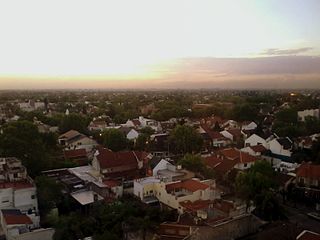
Lomas de Zamora is a city in the province of Buenos Aires, Argentina, located south of the City of Buenos Aires and within the metropolitan area of Greater Buenos Aires. It is the capital of Lomas de Zamora Partido and has a population of 111,897.

Junín is a city in the province of Buenos Aires, Argentina, and administrative seat of the county (partido) of Junín. It has a population of 85,420 and is located 260 km (162 mi) west of the city of Buenos Aires. It is most famous as the hometown of former first lady of Argentina, Eva Peron.

Clarín is the largest tabloid newspaper in Argentina, published by the Grupo Clarín media group. It was founded by Roberto Noble on 28 August 1945 in Buenos Aires. Its director since 1969 was Ernestina Herrera de Noble.

The United Provinces of the Río de la Plata, earlier known as the United Provinces of South America, a union of provinces in the Río de la Plata region of South America, emerged from the May Revolution in 1810 and the Argentine War of Independence of 1810–1818. It comprised most of the former Viceroyalty of the Río de la Plata dependencies and had Buenos Aires as its capital.

Pilar is a city in the province of Buenos Aires, Argentina with a population of 299,077 as per the 2010 census [INDEC]. It is part of the Greater Buenos Aires urban conurbation and is the seat of the administrative division of Pilar Partido. Since the early 1990s, Pilar has gained an increasingly upscale profile due to the development of numerous gated communities, country clubs and polo fields.
The Battle of Cepeda of 1820 took place on February 1 in Cañada de Cepeda, Santa Fe, Argentina.

The Buenos Aires Zoo was an 45-acre (18 ha) zoo in the Palermo district of Buenos Aires, Argentina. The zoo contained 89 species of mammals, 49 species of reptiles and 175 species of birds, with a total of over 2,500 animals. The institution's goals are to conserve species, produce research and to educate the public. In June 2016 the city formed a bias about the zoo's cruelty. They had to close the 140-year-old zoo and relocate most of the animals to nature reserves, including Temaikèn. The zoo property will be converted into an ecopark.

The Treaty of Pilar was a pact signed among the rulers of the Argentine provinces of Santa Fe, Entre Ríos and Buenos Aires, which is recognized as the foundation of the federal organization of the country. It was signed in the city of Pilar, Buenos Aires on 23 February 1820 by governor Estanislao López for Santa Fe, caudillo Francisco Ramírez for Entre Ríos, and provisional governor Manuel de Sarratea for Buenos Aires, after the dissolution of the national government caused by the Battle of Cepeda. A reference to it was included in the Preamble of the Argentine Constitution of 1853 as one of the "pre-existing pacts" fulfilled by it.
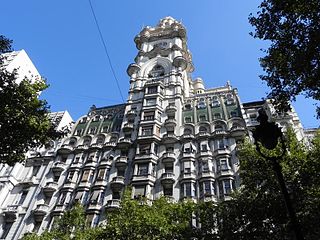
Palacio Barolo is a landmark office building, located at 1370 Avenida de Mayo, in the neighborhood of Monserrat, Buenos Aires, Argentina. When it was built it was the tallest building in the city and South America. Its twin brother, Palacio Salvo, is a building designed and erected in Eclectic style, but of greater height, built by the same architect in Montevideo.
The ATP Buenos Aires originally known as the Argentine Championships and established in 1921 is an annual tennis event for male tennis players held in Buenos Aires, Argentina. The tournament is an ATP World Tour 250 series event on the ATP World Tour, and is played on outdoor clay courts at the 5,500 capacity Buenos Aires Lawn Tennis Club, in the Palermo barrio (neighbourhood). Usually held in February, it includes both a men's singles and a men's doubles tournament. Between 1970 and 1989 it was part of the Grand Prix tennis circuit and a Grand Prix Super Series event (1970–71).
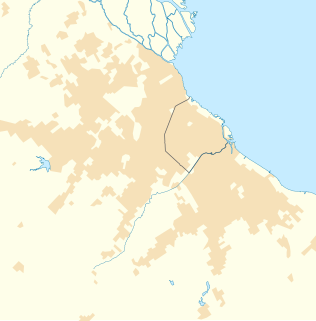
Monte Chingolo is a town in Buenos Aires Province, Argentina. Located in Lanús Partido in the south of the Greater Buenos Aires metropolitan area.

The 2018 Summer Youth Olympics, officially known as the III Summer Youth Olympic Games, and commonly known as Buenos Aires 2018, were an international sports, cultural, and educational event held in Buenos Aires, Argentina between 6 and 18 October 2018. They were the first Summer Youth Olympic Games held outside of Asia, and the first Youth Games for either summer or winter held outside Eurasia. It was the second Olympic Games held in South America after the 2016 Summer Olympics in Rio de Janeiro, Brazil.
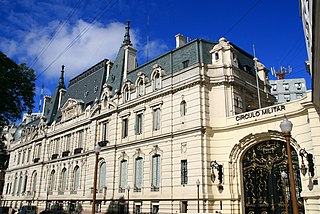
The Paz Palace is a former mansion in Buenos Aires, Argentina, housing the Military Officers' Association, a social club maintained by the Argentine military.
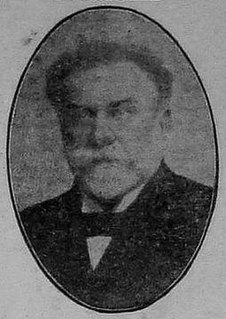
Francisco Seeber was an Argentine military officer, businessman and Mayor of Buenos Aires.
This is a timeline of the history of the city of Buenos Aires, Argentina.
















